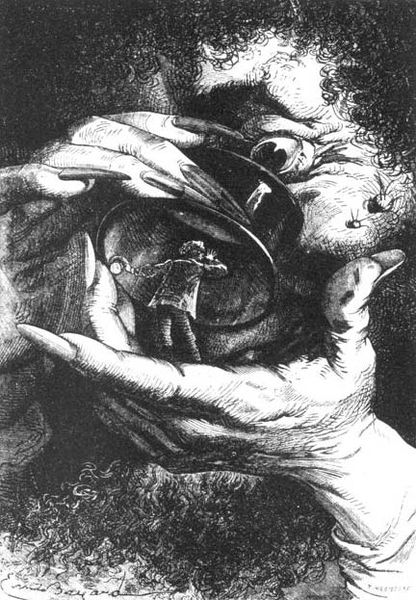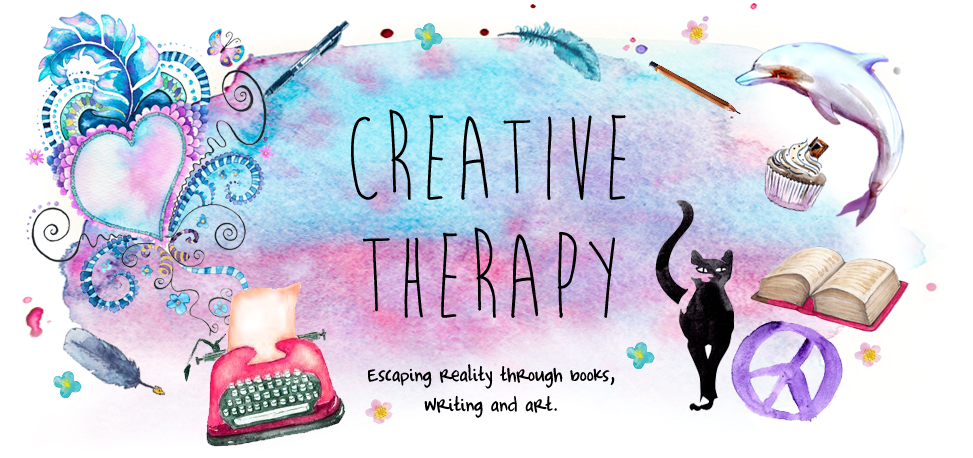 |
| [By Émile Bayard, Public Domain] |
Ogres are large, hideous monsters from mythology and folklore with a penchant for devouring humans (particularly children). They were often described in fairy tales to scare children into obedience. The word ogre is French, but there are a lot of different possibilities as to where the myth comes from. Some say it is based on early descriptions of Neanderthals, or possibly on the real-life crimes of Gilles de Rais (a prolific child serial killer also thought to have inspired the Bluebeard fairytale).
Giants are huge creatures, often larger yet more humanoid in appearance than ogres. They are usually described as violent and unintelligent and feature in Biblical, Roman, Greek and Norse mythology especially. Technically giants are not cannibalistic like ogres, but sometimes the words giant and ogre are used interchangeably. The best known example is the giant in the fairytale Jack and the Beanstalk, who famously declares: 'be he alive or be he dead, I'll grind his bones to make my bread!"
Here are some other examples from books, TV and film:
In Harry Potter
- In the Harry Potter books, ogres and giants are treated as separate creatures. Ogres are barely mentioned, except a reference in a Weird Sisters song and Hermione and Ron reporting that they had seen an ogre-like being in The Three Broomsticks. Giants, however, play a large part in the series.
- Giants are extremely powerful and almost unstoppable, growing up to 20 feet tall. Their numbers have greatly reduced in recent centuries. They usually live away from humans in tribes led by the strongest giant, known as the Gurg. They can comprehend magic although they have no powers of their own. Although they are not as intelligent as humans, they are cleverer than trolls. They have their own language, culture and societal structure, and are capable of learning English and reading.
- They are deeply loathed and feared by the wizarding community, as during the first wizarding war they sided with Voldermort and committed some of the worst atrocities against the muggle community. They are usually violent and barbaric, and extremely dangerous. Despite Hagrid's attempts to recruit them, many of them join Voldermort's side and fight against Hogwarts.
- Half-giants are looked down upon as outcasts of society. When Rita Skeeter writes about Hagrid being a half-giant, many become frightened of him despite having known him for years, and some demanded his resignation. But despite being very large, he is kind and friendly, and has an unusually sentimental nature. His half-brother Grawp is full giant, and although extremely large, clumsy and uncivilised, he turns out to have a gentle nature too, proving that not all giants are bad.
In A Game of Thrones
- Giants are considered to be a legendary race by those who live in the Seven Kingdoms. According to the legends, giants helped Bran the Builder to build the Wall, but Master Luwin says although they may have existed once, they are now long extinct. But that's what they said about dragons...! Osha insists that they actually exist in the north, Beyond the Wall, and wonders whether the unusually tall Hodor might be part giant.
- Jon later comes into contact with giants with Ygritte and the Free Folk. Ygritte tells him they are quite shy, but when provoked they can be violent. She describes how a giant once smashed a man into the ground 'like a hammer to a nail'.
- In the TV show they look much like large humans, wrapped in furs, antlers and grass, but in the books they have a more ape-like appearance, with squashed-in faces.
In The Chronicles of Narnia
- Ogres are portrayed as evil creatures that serve the White Witch. They are very large and not very bright.
- The White Witch is part giant. They generally range from 10-30 feet tall. The Ettins are extremely unintelligent and violent giants that serve the White Witch during many battles. Some have two heads, whilst others have four arms. The Harfangers are more civilised giants with a societal structure and a sytem of government, however they enjoy eating 'man-pie'. Narnian giants are kindly, but not known for their cleverness.
In The Hobbit
- Ogres are mentioned fleetingly in The Hobbit, when Bilbo Baggins and Gollum play the riddle game. Bilbo thinks about them when asked a riddle about something which 'ruins kingdoms' and 'beats tall mountains down'. It's possible that Tolkien's Orcs are based on descriptions of ogres, although in the novels they are related to goblins.
- Giants are said to inhabit the Misty Mountains and hurl rocks at each other for a game during a violent thunderstorm, but Bilbo, Gandalf and the dwarves are the only ones Tolkien ever mentioned as seeing them. Their physical form isn't explained, and they could have been a metaphor. However, in the Peter Jackson film the stone giants are depicted as literal beings made from stone and over 100 feet tall, fighting each other and throwing rocks.
In The BFG
- The Big Friendly Giant in Roald Dahl's BFG subverts all the traditional portrayals of giants. Whilst the other giants snatch children from their beds and gobble them up, the BFG prefers to live off snozzcumber, even though it tastes disgusting. He is a dream maker, and enjoys collecting and mixing different aspects to create a dream that each child will enjoy.
Recommended Reads:






Sources:
http://harrypotter.wikia.com/wiki/Ogre
http://gameofthrones.wikia.com/wiki/Giants
http://harrypotter.wikia.com/wiki/Giant
http://narnia.wikia.com/wiki/Giant


I'm trying to recall if I ever read The BFG. Hmmm, I may have to get the book and read it since I can't remember.
ReplyDelete@Patricia-it's definitely worth reading, even as an adult. I love Roald Dahl books.
ReplyDelete